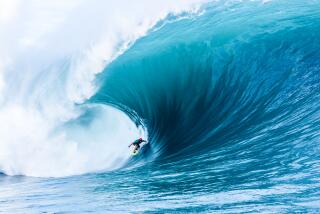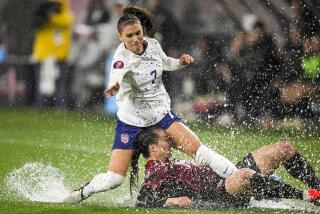America’s Cup Notes : Kiwis Could Win, but Only If . . .
- Share via
SAN DIEGO — Experts are human, too. Even they admit that, yes, given certain circumstances, the underdog could win the America’s Cup next week.
It is a stirring prospect.
The catamaran could capsize.
The catamaran could fall apart.
The catamaran could foul out.
That is, the 60-foot catamaran Stars & Stripes will lose to the 133-foot monohull New Zealand only by self-destructing, it is said.
But could the Kiwis win?
Yes, says Dave Hubbard, who helped design the catamarans.
Hubbard detailed how that could happen, as one would explain how the next guy might flatten Mike Tyson.
The wind?
It would have to be light and aloft. The New Zealand’s 180-foot mast and huge sail area would then come more into play.
The water?
It would be nice for the Kiwis if the spectator fleet generated a great amount of chop--but the fleet will be allowed no closer than half a mile.
The big picture?
“I would say the wind would have to be up to 6 knots, and the New Zealand would have to get away from us, though not necessarily ahead, on the first (of two 20-mile legs),” Hubbard said.
Then, if the Kiwi magic persists, the wind would die to 2-3 knots, allowing the 18,000 square feet of cloth to catch the wind and push the big boat past the gasping cat downwind.
Said Hubbard: “If they had a 2- to 3-mile lead 5 miles from the finish, and then the wind picks up, both boats would pick up speed but not with enough differential (to allow the cat to overtake the big boat.)”
In even 3-4 knot air, each boat likely would beat the time limit, Hubbard said.
The scenario--light breezes, boat separation, wind drop-off and wind pick-up--is unlikely, Hubbard admitted.
How unlikely?
Said Chris Bedford, meteorologist for Stars & Stripes: “I’d say it’s on the order of 5% to 10% that there will be winds 6 knots or below for the duration of the race. It’s probably a 60% chance we’ll have winds ranging from 6-10 knots.”
The winds could determine who gets to ride on the catamaran. The Americans are scheduled to have a 9-man crew. But the number could be 11 or 12 if winds reach 16-18 knots, or 7 if the winds are 6-8 knots.
Even though Kiwis take a greater interest in cricket and rugby, New Zealand nearly came to a stop the last time Conner and Michael Fay squared off for the Cup.
Forty-seven percent of the nation’s available audience watched the third match race from Fremantle, Australia, during the challenger trials for the Cup in 1987. Only the wedding of Prince Charles and Lady Diana has ever drawn more.
These Cup telecasts will not threaten either rating because they will be shown in the morning in New Zealand, and the first two races are scheduled for weekdays.
Besides, New Zealanders are not nearly as excited this time as they were in 1987, according to Peter Montgomery of Radio New Zealand.
“A lot of people in New Zealand think there are too many lawyers, not enough action,” Montgomery said. “A lot of people are turned off.”
America’s Cup Notes
From the mouths of babes, as related by Michael Fay, New Zealand Challenge chairman: “A reporter called the other day and my son, Jimmy (4 1/2) answers the phone. Jimmy yells, ‘My daddy is going to clobber Dennis Conner.’ ”
According to John Marshall, design manager for Stars & Stripes, the Americans have pushed their boat as aggressively as they did in 1986-87, when they improved by 5% a month, then rallied and beat Kiwi Magic at the challenger trials. The Americans have improved boat speeds by 10% since May and are within 3% of their boats’ maximum potential. Conversely, the Americans contend that the Kiwis have sailed less than half as often as did the Americans in August.
A rare positive point made about this Cup, which will feature two vastly dissimilar boats, is that it will lead to a more uniform and more creative design period for the next Cup. What boats would the designers like to see next time? Not 12-meter boats, Marshall said of the class that had dominated since 1958. The boats should be of “reasonable” size and cost, Marshall and Bruce Nelson, another Stars & Stripes designer, said.
“In my heart, it would not be more than 70-feet long (on the waterline), might be a trimaran, might be a cat, might be a foiler like the Blue Arrow (which has proved to be fragile),” Marshall said. “It would be a class that represents the absolute fastest boats in the world and would be raced on a tight, multi-legged course.”
Nelson’s ideal Cup boat in 1991 would be “a fast, exciting one the sellers like to sell so young people get interested in the America’s Cup.” He added: “A 60-foot waterline is plenty big to my way of thinking (12-meter waterlines are 44). It would be better that all would be in similar type boats, and I’d prefer a monohull.”
Kiwi tactician Peter Lester has soft-pedaled the “underdog” theme. “One of the joys of sailing is the underdog always has a chance to win,” he said. “David Barnes knows that. When he was in the Olympic trials, he was beaten (twice) by people who were considered underdogs.” . . . By the final Cup race, the Kiwis will have used about 4 acres of sail cloth. The Kiwis have been cutting sail panels in Point Loma and assembling them at their compound.
Is Fay’s claim that he will protest the race to the New York Superior Court just a bluff, as Tom Ehman Jr. of Sail America has alleged? No, Fay said. “I will have the red flag raised in protest if they show up at the line with a catamaran.” . . . A hurricane that had formed 800 miles south of San Diego has been downgraded to a tropical storm and should not affect the sea condition substantially here.
More to Read
Sign up for Essential California
The most important California stories and recommendations in your inbox every morning.
You may occasionally receive promotional content from the Los Angeles Times.










